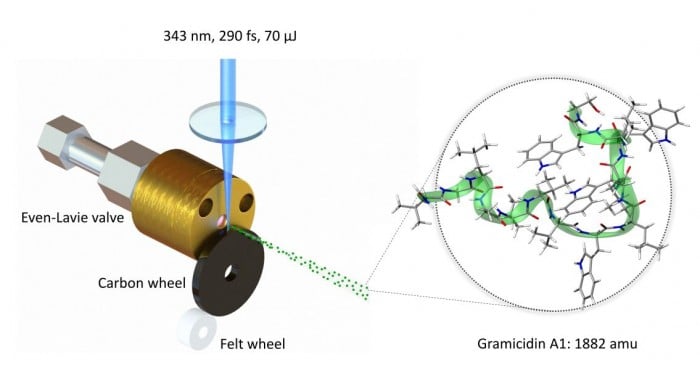A natural biomolecule has been measured acting like a quantum wave for the first time
One of the great counterintuitive puzzles of quantum mechanics is wave-particle duality. This is the phenomenon in which objects behave both like particles and like waves.
Numerous experiments have shown that a single particle—an electron or a photon, for example—can interfere with itself, like a wave. The double slit experiment, in which a particle passes through two slits at the same time, is a famous demonstration.
And because all objects are fundamentally quantum in nature, they all have an associated wavelength. So in principle, macroscopic objects should show this kind of wave-particle duality too, given a sensitive enough experiment.
Physicists haven’t yet devised a way to measure the wavelike nature of very large objects, but their ambition in this respect has been steadily increasing. In 1999, they demonstrated the wave-particle duality of fullerene molecules. And other groups have since done the same with even larger molecules.
And that raises the interesting question of how big they can go. Could they, for example, measure the quantum properties of the molecules of life itself?
Today, they get an answer thanks to the work of Armin Shayeghi at the University of Vienna and a few colleagues, who for the first time, have demonstrated quantum interference in molecules of gramicidin, a natural antibiotic made up of 15 amino acids. Their work paves the way for the study of the quantum properties of biomolecules and sets the scene for experiments that exploit the quantum nature of enzymes, DNA, and perhaps one day simple life forms such as viruses.
Shayeghi and co’s experiment is simple in principle. Their approach is to create a beam of ultracold gramicidin molecules and then to measure the interference pattern created when this beam interferes with itself. This interference pattern is then clear evidence of the wavelike nature of the molecules.
That’s easier said than done. The first problem is creating the beam of individual biomolecules, which are particularly fragile and easy to break apart.
Shayeghi and co do this by coating the edge of a spinning wheel with a thin layer of gramicidin. The team then fires a series of short laser pulses at the wheel to knock the gramicidin molecules off the surface. The laser pulses have to be short enough—just a few femtoseconds in length—to kick the biomolecules without damaging them.

The free-floating gramicidin molecules are then swept up in a beam of argon atoms travelling at 600 meters per second. In this beam, the gramicidin has a wavelength of 350 femtometers (1 femtometer is 1x10-15 meters).
The final step is to measure the pattern created by the wave interfering with itself.
This is perhaps the most difficult bit. The wavelength of the beam is about a thousandth that of the biomolecules themselves (as measured by how closely they can pack together). So the team require a technique that can measure patterns on that scale.
That’s where interferometry comes in. The team use an extraordinarily sensitive technique known as Talbot-Lau interferometry to measure the size of the interference pattern.
And the results are persuasive. “The molecular coherence is delocalized over more than 20 times the molecular size,” say Shayeghi and co. This kind of “smearing“ of the biomolecules would be impossible if the gramicidin molecules were pure particles. It is possible only with wavelike interference.
Other researchers have measured wave-particle duality for larger molecules. But they have used techniques that would tear apart the delicate molecules of life. The new technique will allow more detailed study of the quantum properties of biomolecules.
“The successful realization of quantum optics with this polypeptide as a prototypical biomolecule paves the way for quantum assisted molecule metrology and in particular the optical spectroscopy of a large class of biologically relevant molecules,” say the researchers.
That’s interesting research with significant potential to help to tease apart the fabulously complex processes at work in the machinery of life.
Ref: arxiv.org/abs/1910.14538 : Matter-Wave Interference Of A Native Polypeptide
Deep Dive
Biotechnology and health
How scientists traced a mysterious covid case back to six toilets
When wastewater surveillance turns into a hunt for a single infected individual, the ethics get tricky.
An AI-driven “factory of drugs” claims to have hit a big milestone
Insilico is part of a wave of companies betting on AI as the "next amazing revolution" in biology
The quest to legitimize longevity medicine
Longevity clinics offer a mix of services that largely cater to the wealthy. Now there’s a push to establish their work as a credible medical field.
There is a new most expensive drug in the world. Price tag: $4.25 million
But will the latest gene therapy suffer the curse of the costliest drug?
Stay connected
Get the latest updates from
MIT Technology Review
Discover special offers, top stories, upcoming events, and more.